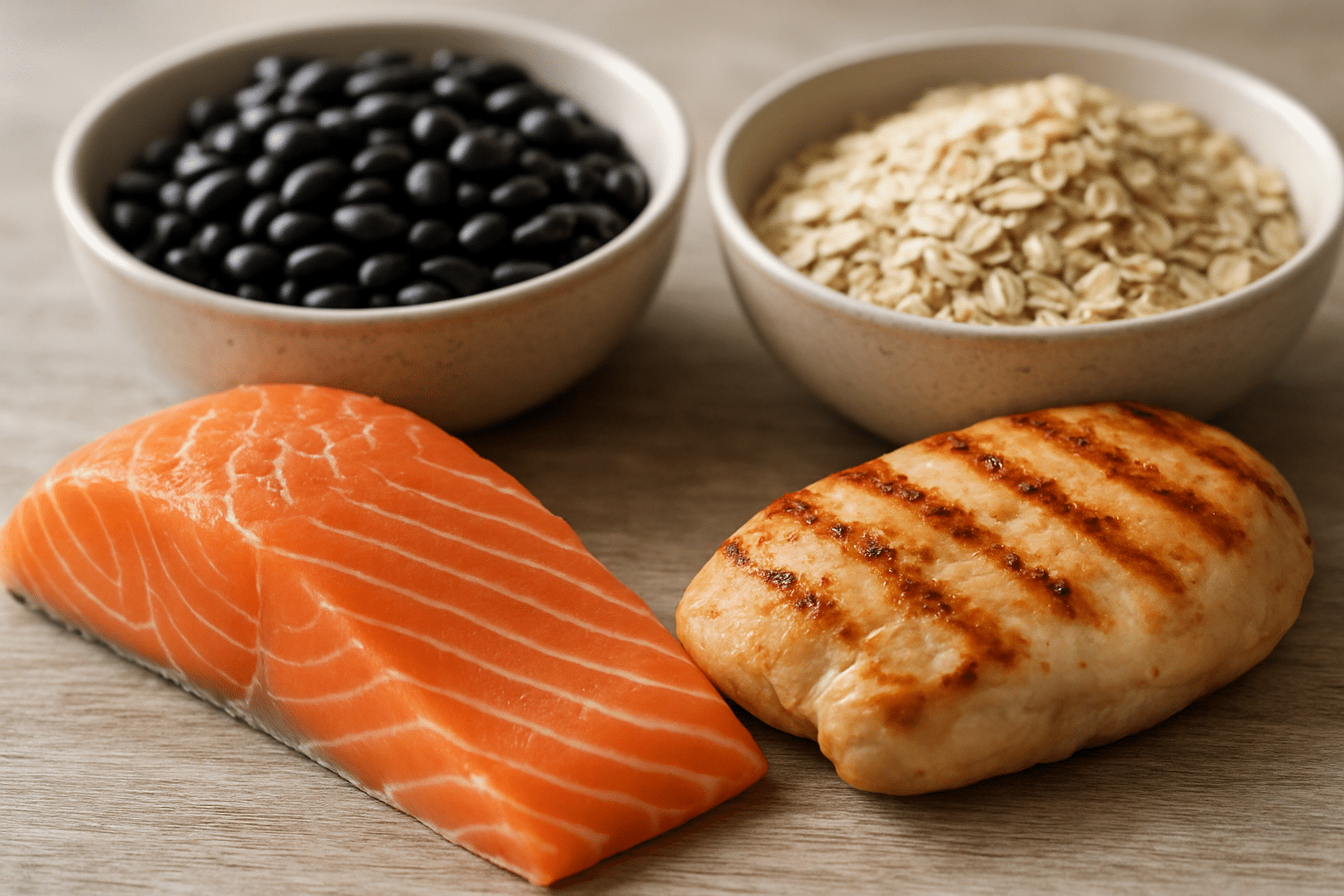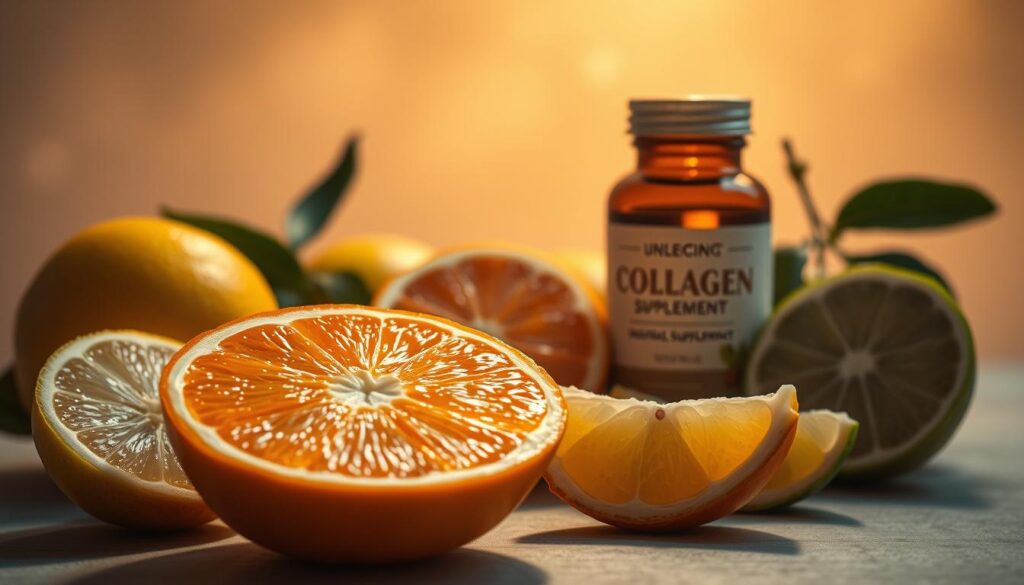This article shows practical, food-first strategies to promote collagen naturally and boost skin health. You’ll get evidence-based guidance on a collagen-rich diet that emphasizes whole foods over quick fixes. Whole foods supply not just amino acids but also vitamin C, zinc, copper, healthy fats, and polyphenols that help build and protect collagen.
We cover a range of skin collagen foods you can add to meals: bone broth, fish and seafood, eggs, citrus fruits, leafy greens, nuts and seeds, plus herbs and superfoods. The plan also includes lifestyle tips and guidance on when supplements, like collagen peptides, might be useful as an addition—not a replacement—for a balanced diet.
Anúncios
Recommendations are grounded in peer-reviewed nutrition research, USDA food composition data, and clinical insights about nutrient roles in skin biology. Use this guide to design a collagen-rich diet that helps support firmer, healthier skin over time.

Natural Foods Rich in Collagen
Key Takeaways
- Focus on natural foods rich in collagen and cofactors rather than relying only on supplements.
- Combine protein sources with vitamin C-rich produce to promote collagen naturally.
- Include bone broth, fish, eggs, citrus, leafy greens, nuts, and seeds regularly.
- Lifestyle factors like sun protection, sleep, and smoking cessation support skin repair.
- Use this article as a meal-planning roadmap to boost skin health over weeks and months.
Why Collagen Matters for Skin Health
Collagen is the backbone of healthy skin. This protein forms a dense network in the dermis that gives tissue strength, maintains thickness, and supports elasticity. Understanding collagen role skin elasticity helps explain why skin looks firm when we are young and why it changes over time.
Role of collagen in skin structure and elasticity
Types I and III collagen dominate the dermal layer and act like scaffolding for cells. They work with elastin and hyaluronic acid to preserve bounce, hydrate tissue, and speed wound repair. Proper collagen levels keep pores less visible and prevent early sagging.
How collagen production changes with age
Endogenous collagen synthesis begins to slow in the late 20s, with a steady aging collagen decline of about 1% per year. Hormonal shifts, increased enzyme activity that breaks down the matrix, and lifestyle factors such as sun exposure and smoking accelerate the pace.
Signs of collagen depletion to watch for
Watch for subtle clues of skin change. Fine lines, reduced rebound in a simple pinch test, dryer texture, and visible sagging are common signs of low collagen. In older adults, thinning skin and more frequent bruising suggest deeper collagen loss.
Natural foods rich in collagen
Eating for healthy skin starts with whole foods that either provide collagen directly or supply the nutrients your body needs to make and protect it. Below are practical, food-first options to add to your menu and simple guidance on when supplements may help.
Animal-based sources deliver collagen and the amino acids your body uses to rebuild skin. Chicken skin, pork skin, beef tendons, and bone-in cuts contain connective tissue rich in collagen. Gelatin, bone broth, and hydrolyzed collagen peptides from bovine, porcine, or marine sources supply glycine, proline, and hydroxyproline, key building blocks for collagen assembly.
Marine collagen from fish skin and scales is high in type I collagen and may be easier for some people to absorb. When choosing animal collagen foods, pick grass-fed or pasture-raised beef and sustainably sourced fish to reduce exposure to contaminants.
Plant nutrients that support collagen do not contain collagen, but they provide the cofactors your body needs to synthesize and protect it. Vitamin C from citrus, bell peppers, and strawberries fuels collagen formation. Copper found in nuts and shellfish, zinc in pumpkin seeds and legumes, and diverse amino acids from beans and whole grains all play roles.
Antioxidant-rich plants such as berries, leafy greens, and green tea help protect existing collagen from oxidative damage. A diet that pairs protein sources with vitamin-C foods improves collagen synthesis and skin benefits.
Comparing whole foods to supplements shows a clear difference in scope. Whole foods deliver fiber, micronutrients, and polyphenols that support overall health and sustained collagen production. Supplements like hydrolyzed collagen peptides can raise circulating amino acids and have clinical evidence of improving skin elasticity and hydration after consistent use.
For most people, a food-first plan that combines animal collagen foods and plant nutrients for collagen is the best approach. Consider collagen supplements vs foods when dietary intake is low or when targeting a specific skin concern, and choose products with third-party testing for quality.
Bone broth and its collagen benefits

Bone broth has become a kitchen staple for people who want gentle, nutrient-dense support for skin and joints. Slow-simmered bones release gelatin, amino acids, and minerals that feed connective tissue. This makes bone broth collagen a practical, whole-food approach to bolstering skin resilience.
What is bone broth and how collagen is extracted
Bone broth is made by simmering bones, marrow, cartilage, and connective tissue for long periods. Low, steady heat breaks collagen into gelatin and smaller peptides that dissolve into the liquid. A splash of apple cider vinegar helps draw minerals and collagen out of the bones, improving yield and nutritional value.
Best practices for making collagen-rich bone broth at home
Choose high-collagen parts such as knuckles, joints, marrow bones, oxtail, or whole chicken carcasses. Simmer poultry for 12–24 hours and beef for 18–48 hours at a gentle simmer, not a rolling boil. Add 1–2 tablespoons of vinegar per gallon of water to enhance extraction. Once cooked, strain and cool; skim fat if you prefer a leaner result. Store in the refrigerator for 3–4 days or freeze in portions.
Recipes and serving suggestions for skin-supporting broths
A simple collagen-rich broth recipe starts with bones, water, a splash of vinegar, onion, garlic, and bay leaf. Simmer, strain, and sip warm as a restorative between meals. For a bright, skin-focused soup, simmer chicken bone broth with grated ginger, turmeric, and a handful of spinach or kale.
Use cooled, skimmed broth to enrich overnight oats or blend into smoothies to boost daily intake without altering flavor too much. For heartier meals, turn beef bone broth into a stew with root vegetables or reduce it into a savory gravy for roasted meats.
Fish and seafood as collagen boosters
Seafood offers a natural way to support skin structure and resilience. Many coastal diets center on fish and shellfish that provide marine collagen foods along with heart-healthy fats. Use these ingredients to boost amino acids and nutrients that help keep skin supple.
Fish skin, scales, and cartilage are rich in type I collagen. Salmon, cod, mackerel, and sardines deliver marine peptides in their flesh and skins. Shellfish such as shrimp and lobster add connective tissue peptides and complementary amino acids that support the body’s repair processes.
How omega-3s and minerals support skin health
EPA and DHA from fatty fish reduce inflammation and help preserve the skin barrier. These omega-3 skin benefits include improved hydration and a slower breakdown of existing collagen. Seafood also supplies zinc and selenium, which aid collagen synthesis and protect cells from oxidative stress.
Cooking tips to preserve nutrient content
Choose gentle methods like baking, steaming, poaching, or quick pan-searing to keep omega-3s intact. Leaving the skin on gives access to collagen-rich portions. Save bones and scraps to simmer a quick fish stock rich in soluble peptides.
Avoid deep-frying or prolonged high heat. Oxidized fats lose their benefits, and heat can degrade delicate peptides. A light finish with lemon, herbs, or a drizzle of extra-virgin olive oil keeps flavor without harming nutrients.
| Seafood | Key benefit for skin | Best cooking method |
|---|---|---|
| Salmon | High EPA/DHA and skin-on collagen | Bake or pan-sear with skin on |
| Cod | Lean source of marine peptides from skin and flakes | Poach or steam to preserve peptides |
| Mackerel | Rich in omega-3s for reduced inflammation | Quick pan-sear or bake at moderate heat |
| Sardines | Compact source of fish collagen sources and minerals | Bake or grill briefly; eat skin for collagen |
| Shrimp & Lobster | Connective tissue peptides and supportive amino acids | Steamed or quick sauté to retain texture |
Eggs and collagen-supporting amino acids
Eggs are a compact source of nutrients that support skin repair and collagen formation. Eating whole eggs supplies a mix of amino acids, vitamins, and healthy fats that work together to nourish skin cells. Below are practical details on which egg parts help collagen, quick egg-based skin meals you can make, and safe alternatives for those with allergies.
Which parts of the egg contribute to collagen formation
Egg whites deliver concentrated amino acids for collagen, including precursors to proline and glycine. These building blocks are crucial when the body assembles new collagen strands.
Egg yolks contain vitamin A, biotin, and healthy fats that support cell turnover and skin barrier health. Those cofactors help the body use the amino acids more effectively.
Consuming whole eggs combines balanced amino acids for collagen with the vitamins and fats that assist repair and maintenance.
Simple egg-based meals for skin health
Start the day with a scrambled egg and spinach mix. Spinach provides vitamin C and iron while eggs contribute amino acids for collagen.
Try soft-boiled eggs over sautéed kale or a vegetable frittata with pumpkin seeds for zinc. These egg-based skin meals pair protein with nutrients that enhance collagen synthesis.
Shakshuka with tomatoes makes a bright, vitamin C–rich meal that supports collagen formation. For snacks, hard-boiled eggs with walnuts add omega-3s and zinc to the mix.
Allergy considerations and alternatives
Egg allergy is common in children and can persist into adulthood. People with egg allergy should skip eggs and rely on other protein sources to obtain amino acids for collagen.
Legumes, tofu, tempeh, and lean meats provide complementary amino acids for collagen when eggs are not an option. Vegans can pair legumes with whole grains to create complete protein profiles.
Focus on vitamin C, copper, and zinc from fruits, nuts, seeds, and vegetables to support collagen pathways when eggs are absent from the diet.
Citrus fruits and vitamin C for collagen synthesis

Vitamin C helps build and repair connective tissue. It acts as a cofactor for the enzymes that hydroxylate proline and lysine, steps that stabilize the collagen triple helix. Adequate intake supports wound healing, limits oxidative damage, and prevents the breakdown that leads to fragile skin and gums.
Vitamin C’s role in collagen formation
Ascorbic acid is required for prolyl and lysyl hydroxylase to function. These enzymes add hydroxyl groups to specific amino acids in procollagen. That modification lets collagen fibers form tight, stable bundles that give skin strength and elasticity.
Best citrus and high-vitamin-C options
Classic citrus for collagen includes oranges, grapefruits, lemons, limes, and tangerines. Non-citrus choices with high vitamin C are kiwifruit, strawberries, papaya, bell peppers, and broccoli. One medium orange supplies about 70 mg of vitamin C toward the recommended daily allowance of roughly 90 mg for men and 75 mg for women in the United States.
Combining vitamin C foods with collagen sources for better absorption
Pair vitamin C-rich foods with collagen-rich meals to support efficient synthesis. Try citrus-marinated salmon or chicken soup finished with lemon and diced bell pepper. A strawberry-spinach salad topped with grilled chicken pairs vitamin C with collagen-supporting amino acids for a simple, effective meal.
Keep in mind that vitamin C is water-soluble and heat-sensitive. To retain potency, add fresh citrus or chopped peppers after cooking when possible. This practice helps maximize the benefit of citrus for collagen while enjoying the best vitamin C foods in your diet.
Leafy greens and antioxidants that protect collagen
Leafy greens deliver a tight mix of vitamins and minerals that support skin structure and help maintain collagen. Eating dark, nutrient-dense leaves supplies vitamin A, vitamin K, folate, magnesium, and trace copper. These nutrients back cell renewal and collagen cross-linking so skin looks firmer and more resilient.
Key vitamins and minerals for skin support
Vitamin C in some greens helps build new collagen while vitamin A supports skin repair. Magnesium and iron keep cells healthy, and copper helps with collagen cross-linking. Antioxidants such as lutein and zeaxanthin lower oxidative stress so antioxidants protect collagen from damage caused by UV and pollution.
Top choices to include regularly
Kale, spinach, Swiss chard, collard greens, arugula, and bok choy rank among the best greens for collagen. Darker leaves tend to provide higher vitamin A and C per serving, boosting antioxidant capacity and offering more support for skin health.
Easy recipes and simple swaps
Blend spinach or kale into a smoothie with citrus and berries for a vitamin-rich drink. Massage kale with lemon juice and olive oil for a tender salad that pairs with grilled salmon or chicken. Sauté Swiss chard with garlic and toasted seeds as a side that adds minerals and flavor.
Replace iceberg lettuce with spinach or mixed greens in sandwiches and wraps to increase daily intake without extra prep. Toss a handful of greens into soups, omelets, or grain bowls to make leafy greens for skin a regular habit that helps antioxidants protect collagen.
Nuts, seeds, and healthy fats for collagen preservation
Small dietary swaps can protect skin structure and keep collagen resilient. Including nuts, seeds, and sources of healthy fats supports cell membranes and reduces inflammation that speeds collagen loss. Pairing these foods with vitamin C and protein helps the body use nutrients efficiently.
How healthy fats and zinc support collagen integrity
Omega-3s and monounsaturated fats keep cell membranes flexible. That lowers inflammatory signals that break down collagen. Fats also help absorb fat-soluble vitamins that protect skin.
Zinc for collagen matters because zinc is a cofactor for enzymes that build and repair collagen. It aids wound healing and supports immune cells that prevent chronic inflammation. Copper works with zinc to form strong cross-links in collagen fibers.
Best nuts and seeds for skin health
Walnuts supply alpha-linolenic acid (ALA), a plant omega-3. Almonds are rich in vitamin E, an antioxidant that defends collagen from oxidative stress. Brazil nuts deliver selenium, which helps shield tissues from damage.
Pumpkin seeds are an excellent source of zinc for collagen support. Chia and flax seeds add more ALA. Sesame seeds offer copper. Sunflower and hemp seeds bring vitamin E and protein for tissue repair.
Snack and topping ideas to increase intake
Aim for about 1 ounce of nuts or 1–2 tablespoons of seeds per serving to control calories while boosting nutrients. Try these simple swaps and snacks:
- Trail mix: pumpkin seeds, almonds, walnuts, a few dried orange zests for vitamin C.
- Chia pudding with berries for added vitamin C and antioxidants.
- Nut-and-seed granola over Greek yogurt to combine protein and healthy fats.
- Salad toppers: hemp seeds or sesame seeds to add texture and zinc.
- Smoothie boost: a tablespoon of ground flax or almond butter for omega-3s and monounsaturated fats.
These choices raise intake of nuts seeds collagen and healthy fats skin collagen while delivering zinc for collagen where the body needs it most.
Collagen-promoting herbs, spices, and superfoods
Start with easy swaps that boost skin resilience. Small daily changes can lower inflammation and protect existing collagen. Focus on flavorful herbs for collagen, bright berries, and warming spices that work well in meals and drinks.
Turmeric and ginger bring anti-inflammatory power. Curcumin in turmeric and gingerols in ginger help reduce the inflammation that speeds collagen breakdown. Pair turmeric with black pepper and a little healthy fat to raise turmeric collagen absorption.
Use turmeric-ginger blends in soups, dressings, and golden milk. Try turmeric in bone broth or a curry to make collagen-rich meals taste vibrant. One to two teaspoons of turmeric in recipes works well for most adults.
Berries deliver vitamin C and protective compounds that shield collagen from oxidative damage. Regular servings of strawberries, blueberries, and raspberries supply the berries polyphenols skin needs to stay supple.
Blend a cup of mixed berries into a spinach-citrus smoothie with Greek yogurt or a scoop of collagen peptides for a quick skin-supporting drink. Green tea and a bit of dark chocolate add extra antioxidants without much effort.
Herbs for collagen extend beyond turmeric and ginger. Fresh rosemary, thyme, and oregano contain polyphenols that support microcirculation and tissue repair. Add them to marinades, roasted vegetables, and grain bowls.
Practical daily plan: aim for one cup of berries, one to two teaspoons of turmeric in cooked dishes, and one to two cups of green tea. These serve as simple targets to enjoy antioxidant protection and steady support for skin collagen.
Try these combo ideas: berry-spinach-citrus smoothies, turmeric-ginger bone-broth soups, and green-tea vinaigrettes. Small, consistent choices add flavor while helping maintain healthy collagen levels.
Dietary tips and lifestyle habits to maximize collagen
Small changes in daily habits make a big difference for skin health. Use meal planning to combine collagen sources with vitamin C and healthy fats. Pairing the right foods helps your body use nutrients more efficiently and can support a long-term plan to maximize collagen diet results.
Meal planning strategies to combine collagen-rich foods
Build simple plates that pair bone broth, fish, or chicken with citrus, berries, and a drizzle of olive oil. A weekly plan could include two seafood dinners, one or two bone-broth soups, daily servings of leafy greens, and nuts or seeds as snacks.
Batch-make bone broth, freeze single-serve portions, and pre-chop citrus and greens for quick salads or smoothies. These steps save time and make it easier to follow a maximize collagen diet during busy weeks.
Lifestyle factors that protect or degrade collagen
Shield skin from excessive UV exposure with broad-spectrum sunscreen and protective clothing. Smoking speeds collagen breakdown, so quitting tobacco protects skin health.
Prioritize 7–9 hours of restorative sleep to support repair and recovery. Manage stress with short walks or breathing exercises to reduce chronic inflammation that harms collagen.
Keep blood sugar steady by limiting high-sugar foods; glycation can stiffen and damage collagen. Regular resistance exercise improves circulation and may help skin tone. Stay hydrated to support skin turgor, though water alone won’t create new collagen.
When to consider supplements and what to look for
Consider hydrolyzed collagen peptides if dietary intake is limited or for targeted skin concerns. Look for third-party testing like NSF, USP, or ConsumerLab to ensure quality.
Choose products with clear source labeling (bovine or marine), hydrolyzed peptides, minimal additives, and allergen information. Formulations that include vitamin C or hyaluronic acid may offer synergy. Use collagen supplement guidance from a registered dietitian or dermatologist when making choices for your specific needs.
Conclusion
Eating a range of natural foods is the clearest path to healthier skin. This natural collagen foods conclusion highlights animal collagen sources like bone broth and fish, vitamin C-rich produce such as citrus, leafy greens, eggs, nuts, seeds, and anti-inflammatory herbs and superfoods. Together these choices form the backbone of a collagen-friendly diet takeaways plan that supports skin structure and resilience.
Practical next steps make change easy. Aim for a food-first approach: try bone-broth soup with lemon and kale, salmon with a squeeze of lemon and roasted spinach, or a berry-spinach smoothie with chia or flax seeds. Pair vitamin C foods with collagen sources to improve absorption and adopt protective habits like regular sunscreen, quality sleep, and avoiding tobacco to boost skin health summary.
If you have unique needs, consult a registered dietitian for tailored meal plans or see a dermatologist about specific skin concerns before starting supplements. Small, consistent changes over weeks and months yield the best results; focus on sustainable patterns rather than quick fixes to protect and preserve collagen for long-term skin benefits.



